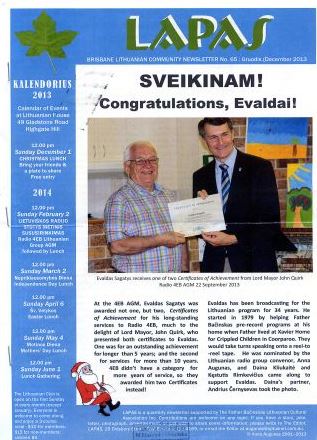Anna Augunas, Editor
The article was originally published in December 2013 issue of “Lapas” (2013, no. 65, p. 10.)

With the announcement on page 2 that subscriptions for Lapas are increasing next year, I would like to acquaint readers with the history of Lapas and how it came into existence.
When I arrived in Brisbane [Australia] in 1990 and first went to the Lithuanian Club in September of that year, I met a number of Lithuanians around my age then (37), give or take a few years either way, who spoke little or no Lithuanian. Some of them told me they grew up feeling they did not fit in as they were brought up Lithuanian, but without speaking the language, so there was an inner turmoil of where they belonged. I related to this too. Although born in Australia, I was brought up Lithuanian also, and when I started school, I didn‘t know a word of English, so I never really fitted in either.
I had been going to Club lunches every first Sunday and joined the committee in 1999 when I suggested introducing a newsletter in English to inform non-Lithuanian speaking Lithuanians about our Club activities. At the time, there were a number of staunch Lithuanians on the committee who were older than I was and thought a newsletter in English was a waste of resources and word of mouth should be enough. The last newsletter that the Club had was many years earlier in Lithuanian. Then in August 2001 and, purely by accident, I found myself President in between elections after the sudden resignation of President John Bliudžius due to work commitments. And I thought: what a great opportunity to introduce the English newsletter and let everyone know about our coming up Christmas and New Year‘s function.
Community members started giving me addresses they had of Lithuanians they knew in Brisbane, the Gold Coast and Sunshine Coast who were not club members. I then went through the White Pages to collect addresses of people with Lithuanian-sounding surnames. I picked a klevas (liquid amber) leaf from my garden, scanned it and put it on the front page with the working title of Lapas (meaning both leaf and page). So, armed with a few hundered addresses, the first issue was sent out in November 2001. It had Baltija Cup on the front cover and articles such as “Meet the President”, the Canberra Sporto Šventė; and a competiton for readers to come up with a title for the newsletter.
The response was so positive, it instantly became bi-monthly and work began on a 10-page issue for January 2002. By the time suggestions started rolling in for a new title—Labas Rytas (good morning), Balsas (voice), Krokodilas (crocodile), Inkaras (anchor), Blebirlas (blabbing) and Pasaga (horseshoe); and rūta (the herb rue) for a logo—the third issue was out and everyone became accustomed to the title Lapas and so it remained. By July, we had over 100 people requesting copies.
In May 2002 Lapas turned into 12 pages and has remained so ever since. If it was any bigger, it would jump into the next postage bracket as it becomes too thick to fit through Australia Post’s cardboard slit—yes, they still use this to measure the thickness of your letter!
Our first joke (Little Johnnie) in Lithuanian appeared in the May 2002 issue and everyone asked for a translation in English so jokes from then on appeared in both languages. Our Famous Lithuanians’ series (The Three Stooges) first appeared in May 2002 too.
At the 2002 October AGM, a new committe was elected and no-one wanted to take on Lapas, so by the following year, it became independent from the Club and became a community newsletter instead and I continued as Editor. It was free throughout 2002, but in 2003 I started collecting an $8 annual subscription to offset costs and sent the money to the Club and in return, they reimbursed the cost of ink and postage. This arrangement remains to this day, except that the Club Treasurer now collects subscriptions. Once it became a community newsletter, people from all over Australia started to send in stories, photos and jokes.
Although Lapas today only has 50 subscribers, they are quite diverse—from a library in Lithuania to all States in Australia— and it seems to be highly regarded, so much so, that the current committee of the Lithuanian Brisbane Club has adopted it as its own; and at the recent November AGM, it voted to increase the cost of subscriptions to $20 and to include it as a bonus for joining the Club.
The increase in subscription costs for six issues has been quite modest over the years. It was free from 2001, $8 in 2003, $10 in 2006 and $12 in 2009. When it became too timeconsuming to keep up six issues, I introduced four issues in 2010—one for each season of the year.
As subscriptions go up to $20 in 2014, we hope you will still see value in supporting it. And, of course, if you join the Club next year, Lapas will be free.